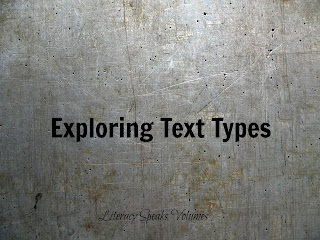Exploring Text Types
Since the earliest days, people have been seeking answers to life's big questions~
- What does it mean to belong?
- Why does the past matter?
- Are people basically good?
- What's really important?
Believe it or not, most of the answers to these questions are found in literature. Exploring different types of literature helps you think about these questions and their answers. Words are a writer's paintbrush. With words, a writer can create a picture so funny, so sad, or so frightening, that you feel like crying or laughing or shuddering in fear. A writer draws you in with his ideas and topics. Family relations, friendly competition, impossible decisions are all ways that authors help us to find the answers to the big questions.
A science fiction writer describes how the sun looks when it becomes a nova. A newspaper reporter describes the terrible damage left by a killer hurricane. With their vivid words, writers make you feel as though you were there--hearing, seeing, feeling, smelling, or tasting what they are writing about. Have you ever described something in writing?
Read the excerpt from Nisei Daughter by Monica Sone
While the Matsuis and our parents reminisced about the good old days, we thumbed through the worn photograph albums and old Japanese tourist magazines. Finally, Mrs. Matsui excused herself and bustled feverishly around the dining room. Then she invited us in. "Sah, I have nothing much to offer you, but please eat your fill."
"Mah, mah, such a wonderful assortment of ogochi-sah," Mother bubbled.
Balding Mr. Matsui snorted deprecatingly. Mrs. Matsui walked around the table with an enormous platter of osushi, rice cakes rolled in seaweed. We each took one and nibbled at it daintily, sipping tea. Presently she sailed out of the kitchen bearing a magnificent black and silver lacquered tray loaded with carmine lacquer bowls filled with fragrant nishme. In pearly iridescent china bowls, Mrs. Matsui served us hot chocolatey oshiruko, a sweetened bean soup dotted with tender white mochi, puffed up like oversized marshmallows.
Father and Mother murmured over the superb flavoring of each dish, while Mr. Matsui guffawed politely, "Nani, this woman isn't much of a cook at all."
I was fascinated with the yaki zak ana, barbecued perch, which, its head and tail raised saucily, looked as if it were about to flip out of the oval platter. Surrounding this centerpiece were lacquer boxes of desserts, neatly lined rows of red and green oblong slices of sweet bean cakes, a mound of crushed lima beans, tinted red and green, called kinton. There was a vegetable dish called kimpira which looked like a mass of brown twigs. It turned out to be burdock, hotly seasoned with red pepper.
Uses of Description
Writers of description always want to create a picture with words, but they don't always use description in the same way or for the same purpose. Here are several ways that you might use description in your writing.
- In a journal entry, describe the emptiness in your old room as you pack for a move to a new house.
- In a letter to a friend, describe the frightening characters and amazing special effects in a science fiction movie you watched.
- In a note to your parents, describe the colorful prize-filled pinata at a birthday party so that your parents will let you have one at yours.
- In a newspaper ad, describe a puppy so that someone will adopt it.
- In an email message to a coworker, describe problems you are having with your computer.
- In a bulletin board notice, give an accurate description of your missing bicycle.
- In a short story, describe the little alien from Mars who is the main character.
- In a poem, describe a spider spinning a web.
When you start your first part-time job, you'll need descriptions of the materials you'll use and the duties you'll perform. When you read your newspaper, you'll read descriptions of soccer or football games. Descriptions are also in ads on the veterinarian's bulletin board and in pamphlets about computers in the computer store. And you can relax and enjoy description in stories, novels, peoms, and plays. The purpose of the descriptions may be differen, but they're all alike in one way. All the writers want you to form a picture or image of their subjects.






Comments
Post a Comment